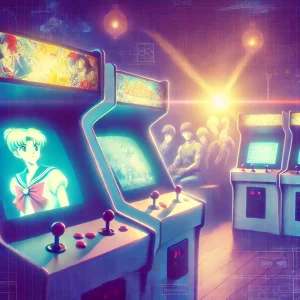Introduction to High Score Girl

When it comes to capturing the essence of the 1990s arcade gaming culture, "High Score Girl" does it like no other anime. Set in an era when the neon glow of arcade machines was an integral part of youth, the show brings the nostalgia of classic gaming to life. Ever wonder what it was like to grow up surrounded by legendary titles like Street Fighter II and Final Fight? Well, "High Score Girl" takes you right into that world.
The story kicks off with Haruo Yaguchi, a sixth-grader who’s obsessed with video games. But here’s the catch – he’s not your typical protagonist. He’s more of an average kid, completely lost in the digital world, and he’s not exactly a shining star in academics or sports. Gaming is his one escape. Enter Akira Oono, a mysterious, quiet girl from a wealthy family who also happens to be a gaming prodigy. This unlikely duo forms a bond, but not in the way you might expect. Akira’s skills completely eclipse Haruo’s, and this creates an interesting dynamic between them. Instead of resenting her, Haruo admires her, and their shared love for arcade games becomes the foundation of their relationship.
Set in the early 90s, the anime doesn’t just use gaming as a backdrop. It’s a crucial part of the story. The show carefully weaves in actual footage of classic games, allowing the viewer to relive the glory days of arcades. Every episode is peppered with references to iconic titles that defined the gaming culture of the time. It’s a walk down memory lane for anyone who grew up during that era, and for those who didn’t, it’s a fascinating look at a time when gaming was rapidly evolving.
What makes "High Score Girl" unique is how it portrays the emotional impact of these games on its characters. Haruo’s journey through life mirrors his journey through the gaming world – full of challenges, triumphs, and defeats. Akira, though seemingly perfect, finds solace in gaming, a place where she can express herself without the pressures of her family’s expectations. The anime cleverly uses arcade games as metaphors for life’s struggles, making it more than just a nostalgic trip for viewers.
So, why does "High Score Girl" resonate so deeply? Perhaps it’s because it taps into the universal feeling of finding something that makes you feel alive. For Haruo and Akira, it’s video games. But for viewers, it could be anything that reminds them of their childhood passions. This anime isn’t just about games – it’s about growing up, forming connections, and finding meaning in the little things, all wrapped up in the pixelated magic of the 90s arcade era.
Plot Overview and Key Themes

The story of "High Score Girl" revolves around the world of arcade gaming in the early 1990s, but it’s much more than just a tale of video games. At its heart, the anime is about growing up, navigating friendships, and discovering the deep connections we form through shared passions. Haruo Yaguchi, the protagonist, is an average boy with one defining trait – he’s absolutely obsessed with video games. They’re his refuge, his joy, and where he feels most at home. But life throws him a curveball when Akira Oono, a seemingly perfect girl from a wealthy family, enters the scene. She’s quiet, reserved, but surprisingly, a gaming genius.
Haruo's first encounter with Akira happens at the arcade, where she completely demolishes him in Street Fighter II. You can imagine his shock – how could someone so different from him, in every way, be so good at the one thing he prides himself on? But this isn’t your typical rivalry. Instead of pushing them apart, it pulls them closer. Their connection grows as they continue to meet at the arcade, each battle a silent conversation between them. Haruo finds himself drawn to Akira, not just because of her gaming skills, but because of the unspoken understanding they share through their love of games.
Now, this anime isn’t just about high scores and game battles. It’s about the nostalgia that games can evoke – a time when life was simpler, and the biggest worry was mastering the next level. For Haruo and Akira, video games aren’t just entertainment; they’re an escape from their realities. Haruo, who struggles academically and socially, finds solace in the pixelated worlds. Meanwhile, Akira, who faces pressure from her family to be perfect, uses games as her sanctuary, a place where she doesn’t have to be the flawless daughter everyone expects her to be.
The theme of nostalgia is central to "High Score Girl". Every game, every arcade visit, brings back memories of a bygone era, not just for the characters but for viewers too. The anime cleverly taps into that longing for the past, especially for those who grew up during the arcade boom of the 90s. There’s something magical about the way the show recreates that period, from the graphics to the sounds of the arcade machines, transporting us back to a time when things felt more tangible, more real.
But beyond nostalgia, "High Score Girl" explores how video games impact relationships. Haruo and Akira’s bond is built through gaming, and it’s through their shared experiences that they understand each other on a deeper level. The games they play together become metaphors for their struggles in life – the wins, the losses, the need to keep trying. And it’s not just about romantic relationships; the anime also highlights how games bring people together, forming friendships and creating memories that last a lifetime.
In essence, "High Score Girl" captures the essence of what it means to grow up, to find comfort in the things we love, and to build connections that go beyond words, all within the colorful, chaotic world of 90s arcade games.
Character Development

In "High Score Girl," character development is deeply intertwined with the characters' experiences in the world of gaming. Haruo Yaguchi, Akira Oono, and Koharu Hidaka each grow significantly throughout the story, shaped by the games they play and the connections they form with each other. Their evolution is gradual, reflecting not only their personal struggles but also how gaming becomes a lens through which they view life.
Haruo Yaguchi starts as your typical slacker, totally absorbed in video games, with little regard for school or social norms. He’s not particularly talented in anything else, and gaming is his escape, his comfort zone. But as the series progresses, we see a different side of Haruo. His encounters with Akira force him to confront his own limitations, both in the gaming world and beyond. At first, he can’t stand losing to her, but as they continue to meet at the arcade, he develops a deep respect for her skills and her quiet determination. Haruo begins to realize that there’s more to life than just chasing high scores. His growth is slow but steady – he starts caring more about the people around him, and his love for games becomes a bridge that helps him understand others, especially Akira.
Then there’s Akira Oono. At first glance, she seems to have it all – intelligence, wealth, and beauty. But gaming is where she finds her true self. Unlike her life at home, where she’s expected to be perfect, the arcade is where she can let loose and just be herself. Akira’s journey is largely internal. She doesn’t speak much, but her actions say it all. Through gaming, she learns to navigate her emotions, especially her growing feelings for Haruo. The more time she spends with him, the more she opens up, not just to him but to the world outside her strict family life. Gaming gives her an outlet, a way to express herself without words, and that’s where her character development truly shines.
Koharu Hidaka, on the other hand, is a character who undergoes a transformation driven by both admiration and frustration. Initially, she’s just a classmate with a mild interest in games, but her growing feelings for Haruo pull her deeper into the gaming world. Watching her fall for Haruo, and simultaneously watching him and Akira bond over their shared passion, pushes Koharu to challenge herself. She’s torn between wanting to connect with Haruo and resenting the fact that she can’t quite match Akira’s skill. Her character development is rooted in this struggle – balancing her emotions, learning to accept herself, and finding her own place in the gaming world, even if it’s different from Haruo’s.
What’s fascinating about "High Score Girl" is how each character’s relationship with gaming reflects their personal growth. For Haruo, games are no longer just an escape; they become a way to connect with others. For Akira, they’re a means of breaking free from societal expectations. And for Koharu, they’re a way of discovering who she really is. Their shared experiences in the world of gaming shape their personalities, relationships, and ultimately, the way they view life. Through every win and loss, these characters learn valuable lessons about themselves and the world around them.
The Role of 90s Gaming in High Score Girl

In "High Score Girl," 90s arcade games play a pivotal role, almost becoming characters in their own right. One of the most iconic games featured is Street Fighter II, a title that dominated the arcades during that era. For the characters in the anime, these games aren’t just pastimes; they’re integral parts of their lives, shaping their relationships, their growth, and even their worldview.
Let’s talk about Street Fighter II. If you grew up in the 90s, you probably remember the thrill of picking your favorite character and pulling off that perfect combo. In High Score Girl, this game represents more than just competition. It’s a form of communication, a way for the characters to express themselves when words aren’t enough. Take Haruo, for instance. He’s not the best at expressing his emotions, especially to Akira, but through their battles in Street Fighter II, they connect in a way that transcends typical conversation. Their matches are more than just games – they’re an unspoken dialogue.
Arcade games like Street Fighter II also symbolize the era’s culture. Back in the day, arcades were social hubs, places where kids gathered to challenge each other, form friendships, and even rivalries. For Haruo, the arcade is his sanctuary, a place where he feels in control and understood. It’s where he meets Akira, and it’s where their bond begins. The game’s cultural significance is undeniable. It’s not just about the mechanics or the gameplay – it’s about the memories tied to it. For viewers who lived through the 90s, seeing these games brought to life in the anime is like opening a time capsule. Every sound effect, every sprite animation triggers nostalgia.
But it’s not just Street Fighter II that makes an appearance. Final Fight, Splatterhouse, Mortal Kombat, and countless others make their mark in the show. Each game reflects a different aspect of 90s gaming culture. For example, Final Fightcaptures the era's fascination with beat-em-ups, where teamwork and strategy played crucial roles. Watching Haruo and Akira navigate through these games together reinforces the idea that gaming is a collaborative experience, a shared journey. It’s a subtle reminder of how video games were, and still are, a medium for building connections.
The anime doesn’t shy away from showing the impact of these games on the characters' lives. Haruo, who struggles with school and fitting in, finds a sense of belonging in the arcade. Akira, burdened by the expectations of her family, escapes into the world of games to find solace. Even Koharu, who initially sees games as just another hobby, slowly realizes the emotional depth they hold. For these characters, gaming is more than just a distraction – it’s a lifeline, a way to navigate the complexities of growing up.
Culturally, these games represent the spirit of the 90s – a time of rapid technological growth, where arcades were at the forefront of entertainment. The anime captures this beautifully, showcasing not only the games themselves but also the impact they had on a generation of players. Whether it’s the thrill of landing a perfect combo in Street Fighter II or the excitement of beating a high score in Final Fight, High Score Girl reminds us of the power that games had in shaping both individual lives and the culture of an entire era.
Reception and Cultural Impact
![]()
When "High Score Girl" first aired in Japan, it quickly gained a dedicated following. The show’s blend of nostalgia, gaming culture, and heartfelt storytelling struck a chord with viewers who had grown up in the 90s, as well as a younger audience curious about the golden age of arcades. The anime was praised for its accurate portrayal of retro games and the way it seamlessly integrated them into the narrative. Fans loved how the characters' lives were interwoven with the games they played, making the series a celebration of gaming history rather than just another slice-of-life anime.
Internationally, the reception was equally enthusiastic. When Netflix picked up "High Score Girl" for global distribution, it opened the door for non-Japanese audiences to experience this unique blend of romance and arcade nostalgia. Gamers around the world were thrilled to see titles like Street Fighter II and Final Fight brought to life on screen with such attention to detail. For many, it was a trip down memory lane, sparking renewed interest in retro gaming.
But what makes "High Score Girl" stand out isn’t just its appeal to gamers. The anime tapped into a broader cultural phenomenon – the resurgence of interest in retro games. In recent years, there’s been a growing movement to preserve and celebrate the classics, from the release of mini-consoles like the NES Classic to the rise of indie games that draw inspiration from 8-bit and 16-bit graphics. "High Score Girl" rode the wave of this trend, contributing to the revival of retro gaming by reminding people why these games were so special in the first place.
Culturally, the anime had a significant impact. It wasn’t just about rekindling love for old games; it also shone a spotlight on the gaming community’s evolution. The show demonstrated how games can create lasting connections, transcend language barriers, and serve as a universal form of communication. By showcasing the emotional ties that people form through gaming, "High Score Girl" helped legitimize the idea that video games are not just entertainment but also a meaningful part of people’s lives.
In Japan, "High Score Girl" sparked discussions about the importance of preserving gaming history. The anime highlighted how arcade culture was an essential part of many people’s upbringing and how the games of that era played a crucial role in shaping modern gaming. The detailed references to actual arcade games also fostered a sense of authenticity that resonated with both casual viewers and hardcore gaming enthusiasts.
Globally, the anime’s influence extended beyond just the gaming community. Its success on platforms like Netflix introduced a whole new audience to the world of anime, retro gaming, and Japanese pop culture. "High Score Girl" played a part in the growing appreciation for anime that focuses on niche subcultures, showing that even highly specific topics like 90s arcade gaming could have broad, universal appeal.
Ultimately, "High Score Girl" has become more than just an anime – it’s a cultural touchstone that celebrates a pivotal era in gaming history while also bridging the gap between generations of gamers. Whether you’re a seasoned arcade veteran or someone discovering these classics for the first time, the anime captures the joy, frustration, and triumph of gaming in a way that resonates long after the credits roll.
